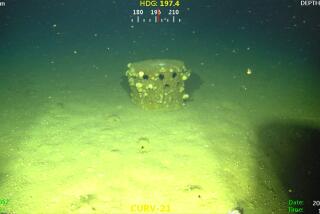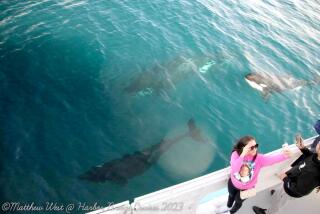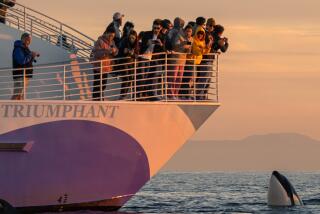Navy dolphins discover rare old torpedo off Coronado
- Share via
SAN DIEGO — In the ocean off Coronado, a Navy team has discovered a relic worthy of display in a military museum: a torpedo of the kind deployed in the late 19th century, considered a technological marvel in its day.
But don’t look for the primary discoverers to get a promotion or an invitation to meet the admirals at the Pentagon — although they might get an extra fish for dinner or maybe a pat on the snout.
The so-called Howell torpedo was discovered by bottlenose dolphins being trained by the Navy to find undersea objects, including mines, that not even billion-dollar technology can detect.
“Dolphins naturally possess the most sophisticated sonar known to man,” Braden Duryee, an official at the Space and Naval Warfare Systems Center Pacific said after the surprising discovery.
While not as well known as the Gatling gun and the Sherman tank, the Howell torpedo was hailed as a breakthrough when the U.S. was in heavy competition for dominance on the high seas. It was the first torpedo that could truly follow a track without leaving a wake and then smash a target, according to Navy officials.
Only 50 were made between 1870 and 1889 by a Rhode Island company before a rival copied and surpassed the Howell’s capability.
Until recently only one Howell torpedo was known to exist, on display at the Naval Undersea Museum in Keyport, Wash. Now a second has been discovered, not far from the Hotel del Coronado.
Meant to be launched from above the water or submerged torpedo tubes, the Howell torpedo was made of brass, 11 feet long, driven by a 132-pound flywheel spun to 10,000 rpm before launch. It had a range of 400 yards and a speed of 25 knots.
Its specifications seem primitive today, but in the late 1800s, it was a leap forward in military armament.
“Considering it was made before electricity was provided to U.S. households, it was pretty sophisticated for its time,” said Christian Harris, operations supervisor for the biosciences division at the Systems Center Pacific.
Marine mammals have been trained at the Navy’s Point Loma facility since the 1960s.
Several species were tested before the Navy settled on the bottlenose dolphin and the California sea lion. Dolphins, in particular, have deep and shallow diving capability, great eyesight and a biosonar system that scientists admire but don’t fully understand.
At the Point Loma facility, 80 dolphins and 40 sea lions are being trained for mine detection, mine clearing and swimmer protection. When the U.S. led an invasion of Iraq in 2003, dolphins were rushed to the Persian Gulf to patrol for enemy divers and mines. Dolphins guard U.S. submarine bases in Georgia and Washington state. This fall, dolphins will deploy for a mine-hunting mission off Croatia.
To train the dolphins, Navy specialists sink objects of various shapes in rocky and sandy undersea areas where visibility is poor. The shapes mimic those of the mines used by U.S. adversaries.
A dolphin is then ordered to dive and search. If it finds something, it is trained to surface and touch the front of the boat with its snout. If it has found nothing, it touches the back of the boat.
When a dolphin named Ten surfaced from a shallow-water dive last month and touched the front of the boat, Navy specialists were nonplused. “It went positive in a place we didn’t expect,” said Mike Rothe, who heads the marine mammal program.
A week later, a dolphin named Spetz did the same thing in the same area. This time, the dolphin was ordered to take a marker to the object.
Navy divers and then explosive-ordnance technicians examined the object, which was in two pieces, and determined that the years had rendered it inert. On one piece was the stamp “USN No. 24.”
The torpedo pieces were lifted to the surface and taken to a Navy base for cleaning and to await shipment to the Naval History and Heritage Command, located at the Washington Navy Yard.
The dolphins have found unexpected things in the past, including a mine-shaped lobster trap during a mission off Canada with the Canadian navy. But a torpedo that was more than a century old and that the divers and trainers needed to consult explosives experts — and Google — to identify?
“We’ve never found anything like this,” said Rothe, his voice full of admiration for the marine mammals. “Never.”
More to Read
Sign up for Essential California
The most important California stories and recommendations in your inbox every morning.
You may occasionally receive promotional content from the Los Angeles Times.










